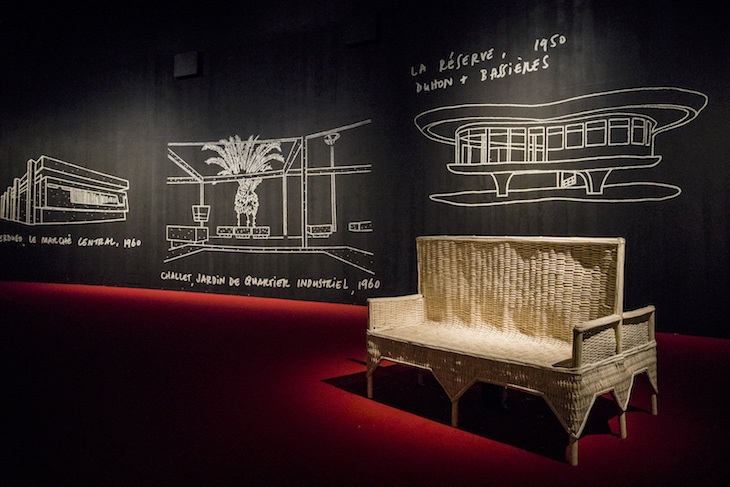Since 1963, a thin, concrete tower has presided over the central skyline of the Moroccan city of Agadir, on each side of which sits a neat, compass-like clock. The tower, designed by Moroccan-French architect Jean-François Zevaco, marks the entrance to the city’s fire station, which swells into an expansive ring of concrete beneath. Its construction marked a new era in Agadir’s architectural landscape; completed three years after a disastrous earthquake sent much of the city crashing to the ground, the new fire station was solid, grounded – an emblem of stability.
Representations of the buildings of Agadir, including Zevaco’s fire station, can currently be found lining a wall in the Barbican Centre – one of London’s most solid, grounded buildings. Moroccan-French artist Yto Barrada has created white line drawings on the black wall of the Curve gallery, using the pre-earthquake and post-earthquake architecture of the city, as an introduction to her exhibition ‘Agadir’ – an immersive investigation into the city’s defining, tragic moment, organised on her own compelling terms. The exhibition takes the natural disaster as its cue and the Curve has been filled with sketches, gouaches, wicker furniture, performances, audio and video, to draw in the city’s mid 20th-century inhabitants and buildings – the things that perished, and the things that survived.
Installation view of ‘Yto Barrada: Agadir’ at The Curve, Barbican Centre, 2018. Photo: Tristan Fewings/Getty Images
Walking back and forth through the Curve, one gets the sense that Barrada has been wrestling with the ghosts of Agadir for quite some time. When the earthquake hit, just before midnight on 29 February 1960, it levelled much of the blossoming port city, and killed between 12,000 and 15,000, nearly one third of the population. Zevaco and other modern architects, known as the ‘architectes de la rupture’ were recruited to begin the reconstruction process, and their moniker took on a double meaning: they had already broken with architectural tradition in favour of brutalism and functionalism; they were now architects charged with rebuilding a broken city.
Barrada’s drawings of buildings such as Zevaco’s form an architectural timeline along the outer wall of the Curve, but are activated by the central part of the exhibition: multiple voices of Agadir put forth by author Mohammed Khaïr-Eddine. Taking selections from the newly-translated edition of his 1967 book Agadir, Barrada worked with actors from the Guildhall to record passages from the text, which was initially commissioned by the Moroccan government as a report of the city, post-quake. The result, a genre-defying script of sorts, was anything but report-like, and ripe for performance. Piped into the wicker ‘conversation chairs’ throughout the gallery, the unruly and enthralling narratives see multiple characters grappling not only with the physical reconstruction of their lives, but with pressing political questions of a country recently liberated from colonial rule. ‘Prophet – find us a real God!’ one voice begs, ‘I hate the principles of monarchy!’
On Saturdays throughout the run of the exhibition, the Guildhall actors wander the Curve, performing the passages while weaving in and out of the furniture, encouraging the free flow of the exhibition space and interaction with the wicker sculptures. Just as there is no linear way to experience a city, Barrada has left the route through ‘Agadir’ up to the visitor, and there is plenty to return to – especially the collaged gouaches that line the inner wall of the Curve, and the short film, Anagramme Agadir (2018), which functions as a sort of ‘epilogue’ to the installation.
Installation view of ‘Yto Barrada: Agadir’ at The Curve, Barbican Centre, 2018. Photo: Tristan Fewings/Getty Images
The series of collages and the film both deal with the press coverage of the earthquake itself – a step away from Khaïr-Eddine’s personal accounts and the unpopulated architectural sketches. The collages are hypnotising; press photographs of the damage and their accompanying captions chopped and backed with Barrada’s painted wallpaper designs, crumbling exteriors betraying possible interiors. It’s here we get the quick-read, news version of the disaster: ‘AGADIR EARTHQUAKE: Two houses shattered by the earthquake. In background a house which by miracle suffered no damage.’ Punctuated by some reporting inaccuracies (‘More than 30,000 persons perished in the quake’), there is clearly some clever critique of the news industry, past and present, here at work.
Where the collages are overrun with the word ‘earthquake’, Anagramme Agadir leaves out all mention of the disaster itself. Editing press footage from the aftermath, Barrada has left us with the reactions of survivors, which, when divorced from their context, take on a surreal quality, from one man’s replication of the sounds he heard during the night, to a woman’s aloof admission that she continued sleeping as the city collapsed around her. As with the Khaïr-Eddine text, these personal accounts give life to the simple architectural drawings on the wall – how would these buildings figure in the lives of the survivors, and vice versa?
Installation view of ‘Yto Barrada: Agadir’ at The Curve, Barbican Centre, 2018. ay 2018. Photo: Tristan Fewings/Getty Images
Towards the exit of the Curve, a wicker mobile hangs overhead, lit so that its shadows line up next to the architectural drawings by Zevaco and the other ‘architectes de le rupture’. When examined by Barrada, the subtle relationships informed by the Agadir earthquake of 1960 transcend materials, decades, and countries: the thin, bendable wicker becomes solid in its shadows, just another brutalist shape in the timeline of rebuilt Agadir, on the curved brutalist wall of the Barbican.
‘Yto Barrada: Agadir’ is at the Barbican Centre until 20 May 2018.
